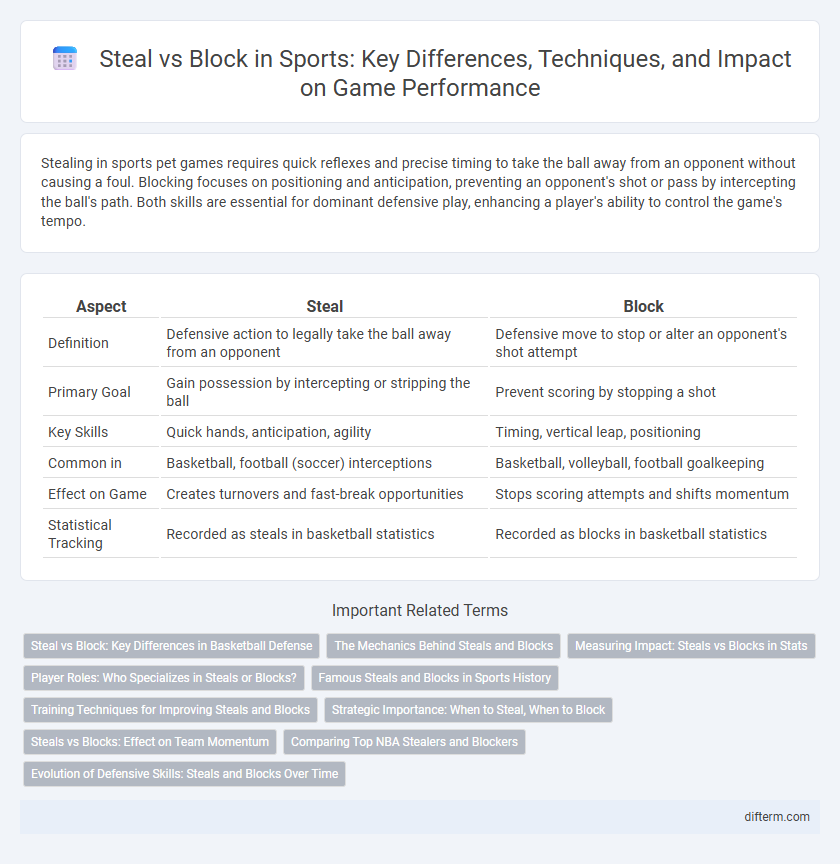Stealing in sports pet games requires quick reflexes and precise timing to take the ball away from an opponent without causing a foul. Blocking focuses on positioning and anticipation, preventing an opponent's shot or pass by intercepting the ball's path. Both skills are essential for dominant defensive play, enhancing a player's ability to control the game's tempo.
Table of Comparison
| Aspect | Steal | Block |
|---|---|---|
| Definition | Defensive action to legally take the ball away from an opponent | Defensive move to stop or alter an opponent's shot attempt |
| Primary Goal | Gain possession by intercepting or stripping the ball | Prevent scoring by stopping a shot |
| Key Skills | Quick hands, anticipation, agility | Timing, vertical leap, positioning |
| Common in | Basketball, football (soccer) interceptions | Basketball, volleyball, football goalkeeping |
| Effect on Game | Creates turnovers and fast-break opportunities | Stops scoring attempts and shifts momentum |
| Statistical Tracking | Recorded as steals in basketball statistics | Recorded as blocks in basketball statistics |
Steal vs Block: Key Differences in Basketball Defense
Steal and block are two critical defensive techniques in basketball with distinct objectives and execution. A steal involves taking possession of the ball from an opponent, usually through intercepting a pass or stripping the ball, which directly disrupts the offensive flow. A block occurs when a defender legally deflects or stops a shot attempt, preventing the ball from reaching the basket without committing a foul, emphasizing rim protection.
The Mechanics Behind Steals and Blocks
Steals require precise timing, quick hand-eye coordination, and anticipation to successfully disrupt an opponent's ball control without committing a foul. Blocks demand vertical leap ability, hand positioning, and spatial awareness to intercept or alter an opponent's shot trajectory while maintaining legal contact. Both skills are critical defensive techniques that hinge on body mechanics and split-second decision making to change game momentum.
Measuring Impact: Steals vs Blocks in Stats
Steals and blocks are key defensive metrics that measure different aspects of a player's impact on the game. Steals reflect a player's ability to disrupt the opponent's ball control and create fast-break opportunities, often quantified by turnover rates and points off turnovers. Blocks indicate rim protection and shot deterrence, impacting opponent field goal percentage in the paint and providing a psychological advantage defensively.
Player Roles: Who Specializes in Steals or Blocks?
Point guards and shooting guards typically specialize in steals due to their quick hands, agility, and ability to anticipate opponents' passes. Centers and power forwards focus on blocks by using their height, timing, and shot-altering presence near the rim. Defensive specialists in these positions play crucial roles in disrupting the opposing team's offense through steals or blocks.
Famous Steals and Blocks in Sports History
Famous steals like Larry Bird's dramatic steal in the 1987 Eastern Conference Finals and Michael Jordan's iconic steal in the 1997 NBA Finals showcase pivotal moments that changed game outcomes. Equally legendary are blocks such as LeBron James' chase-down block in the 2016 NBA Finals and Vince Carter's rim-shattering rejection during the 2000 NBA Slam Dunk Contest, defining defensive excellence. These signature plays highlight the critical impact of steals and blocks in sports history, emphasizing both quick reflexes and strategic mastery.
Training Techniques for Improving Steals and Blocks
Training techniques for improving steals and blocks emphasize agility drills, hand-eye coordination, and anticipation skills. Defensive footwork exercises combined with reaction time training help players effectively disrupt opponents' plays. Strength training and vertical jump workouts enhance blocking ability, while situational practice improves timing for successful steals.
Strategic Importance: When to Steal, When to Block
Stealing in sports is strategically ideal during moments when the opponent exhibits predictable ball handling or weaker passing lanes, maximizing the chance of gaining possession without committing fouls. Blocking becomes crucial primarily in defensive scenarios against close-range shots or fast breaks, disrupting the opponent's scoring opportunities and controlling the game's tempo. Optimal decision-making between stealing and blocking hinges on situational awareness, player positioning, and understanding the opponent's tendencies.
Steals vs Blocks: Effect on Team Momentum
Steals rapidly shift team momentum by creating immediate scoring opportunities through turnovers, energizing both players and fans. Blocks, while impactful for defensive stops, often serve as momentum setters by halting opponent drives and inspiring defensive intensity. Teams with high steal rates tend to generate faster-paced play and increased transition points, directly influencing game flow and momentum swings.
Comparing Top NBA Stealers and Blockers
Top NBA steal leaders like Chris Paul and T.J. McConnell showcase exceptional defensive anticipation and quick hands, averaging over 2 steals per game in peak seasons. In contrast, elite shot blockers such as Rudy Gobert and Myles Turner dominate the paint with 3-plus blocks per contest, demonstrating superior timing and vertical reach. Comparing these defenders highlights how steals disrupt offensive flow through perimeter pressure, while blocks protect the rim by altering shot attempts near the basket.
Evolution of Defensive Skills: Steals and Blocks Over Time
Steals and blocks have evolved into critical defensive skills in sports, reflecting changes in player agility, anticipation, and tactical awareness. Modern athletes demonstrate increased precision in timing steals to disrupt offensive plays and utilize vertical leap and hand-eye coordination to execute effective blocks. Advances in training and analytics have refined these skills, resulting in higher defensive impact and game-changing moments on the court or field.
steal vs block Infographic

 difterm.com
difterm.com